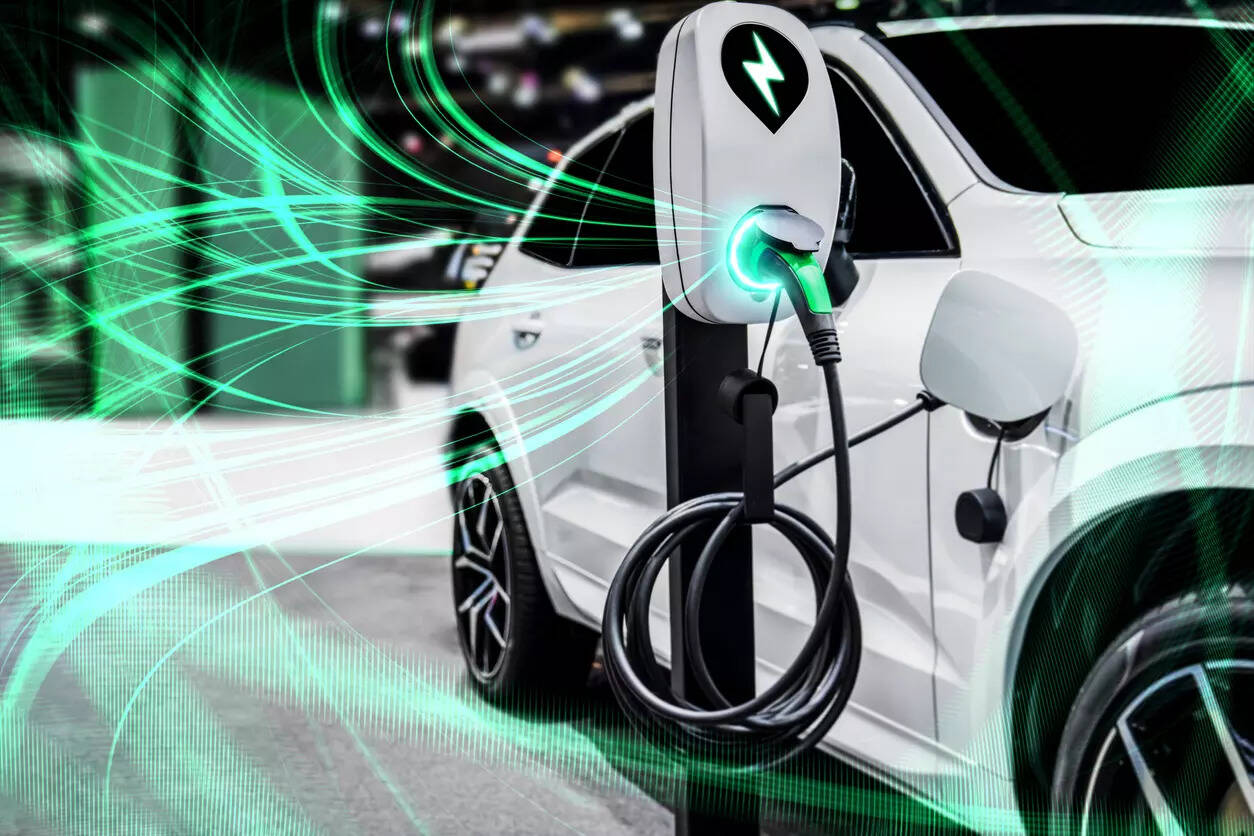
EVs are only as clean as the electricity that fuels them. Without developing increased renewable power alternatives, current EV growth will, contradictorily, result in prolonging the usage of fossil fuel-generated power sources.
A study of Tsinghua University, Beijing, in 2016 had concluded that the increased adoption of EVs in China, resulted in the release of two to five times higher particulate matter and emissions than gasoline engine cars, when approximately 64% of electricity was generated from coal-fired resources. It is estimated that approximately 60% of electricity in China currently continues to be delivered from coal-fired resources.
In 2022, EVs constituted approximately 10% of global vehicle sales — a roughly four-fold increase in the global market share for EVs over 2019 sales. Estimates indicate that EVs will account for approximately 45% of new car sales by 2035. The International Energy Agency (IEA) estimates that by 2040, global electricity demand will grow by more than one-third, mainly due to widespread adoption of EVs, escalating the transportation sector’s electricity demand from essentially zero, to over 4,000 terawatt hours (TWH) per year.
Sourcing Renewable Energy for fuelling EVs
Car manufacturers and charging companies have recognized the importance of sourcing renewable energy sources for powering EVs, with consumers placing greater importance on the original source of electricity generation. The combined effect of vehicle electrification, and adoption of renewable power sources can have a profound impact on reducing emissions.
If we truly want to achieve a zero-carbon result, it is critical that renewable generated energy is used as the ultimate source for charging electric vehicles, for the following reasons:
Carbon emissions: The primary goal of transitioning to renewable energy is to reduce carbon emissions. The transportation sector is responsible for a significant portion of global carbon emissions, and the widespread adoption of electric vehicles is seen as a key way to reduce those emissions. However, if those vehicles are charged using energy generated from fossil fuels, the benefits of the shift to electric vehicles is largely negated.
Sustainability: Fossil fuels are finite resources, meaning that they will eventually run out. Renewable energy sources, such as solar, wind, and hydroelectric power, are sustainable and will never run out. Using renewable energy to power electric vehicles ensures that we are not depleting finite resources in the process.
Environmental impact: Extracting and burning fossil fuels has significant environmental impacts, including air and water pollution, habitat destruction, and the release of greenhouse gases. The production and disposal of batteries for electric vehicles also has environmental impacts, but using renewable energy to charge those batteries can help minimize the overall environmental impact of electric vehicles.
Economic benefits: Transitioning to renewable energy can also have economic benefits, including job creation, reduced reliance on imported energy sources, and increased energy security.
Using renewable energy as the ultimate source for charging electric vehicles is critical if we want to achieve a zero-carbon result and transition to a more sustainable, environmentally-friendly, and economically-viable energy system.
What are the Renewable Energy Options and Potential?
Renewable energy is key to achieving decarbonization, and reducing dependence on fossil fuels. Some notes about renewable energy that highlight the importance and potential of these resources:
⦁ Renewable Energy is expected to be the largest source of electricity by 2035, with solar energy leading the way, surpassing coal and natural gas. This growth is driven by a combination of declining costs and government policies that support renewable energy development.
⦁ Solar Energy is one of the fastest-growing renewable energy sources, with photovoltaic (PV) solar installations increasing by 30% in 2022. The cost of solar energy has fallen by nearly 90% in the past decade, making it more competitive with fossil fuel sources.
⦁ Wind Energy is another rapidly growing renewable energy source, with wind power capacity increasing by 120 gigawatts (GW) in 2022. The global wind power capacity is expected to reach 1,200 GW by 2030.
⦁ Hydroelectric Power currently remains the largest source of renewable energy worldwide, accounting for 18% of current global electricity generation. However, growth in hydroelectric power has slowed in recent years due to environmental concerns and limited opportunities for new installations.
⦁ Geothermal Energy is a largely untapped renewable energy source that has great potential. Geothermal energy harnesses the natural heat of the earth to generate electricity and heat buildings. Currently, geothermal power only accounts for 0.3% of global electricity generation, but it has the potential to grow significantly.
⦁ Biomass is another renewable energy source that uses organic matter, such as wood chips, agricultural waste, and municipal solid waste, to generate electricity and heat. Biomass accounts for around 5% of global energy consumption and has the potential to grow, but it is not without its challenges, such as concerns about sustainability and air pollution.
Renewable energy is not only good for the environment but also for the economy. It is estimated that the renewable energy sector employs over 11 million people worldwide, and this number is expected to continue to grow. In addition, renewable energy investment stimulates economic growth, and reduce energy costs.
Can India Manage its EV Transportation Growth Through Renewables?
India has significant potential for generating renewable energy, including solar, wind, and hydroelectric power. The country has set ambitious targets to increase its renewable energy capacity and has made significant progress in recent years. However, meeting the domestic transport needs solely through renewable energy sources could be a challenging task for India, given the current infrastructure and technological limitations.
India has already become one of the world’s largest producers of renewable energy, and the country has set a target of achieving 450 GW of renewable energy capacity by 2030. While this target is ambitious, with the right policies, investment, and innovation, India has the potential to achieve it,.
In terms of transportation, electric vehicles are becoming increasingly popular in India, and the government is pushing for the adoption of electric vehicles to reduce carbon emissions. However, challenges remain in terms of charging infrastructure and grid stability, which need to be first addressed to support the growth of electric vehicles in the country.
Is Green Hydrogen a Possible Solution?
Green hydrogen is an emerging technology that is gaining traction as a renewable option for the energy sector. It is produced through the process of electrolysis, which uses electricity generated from renewable sources to split water molecules into hydrogen and oxygen. The resulting hydrogen can be used as a fuel for transportation, heating, or industrial processes, and its only by-product is water vapor.
Another advantage of green hydrogen is that it can be used in a variety of applications, from powering vehicles to providing heat and electricity for buildings. This versatility makes it a promising option for countries seeking to transition to renewable energy sources and reduce their reliance on fossil fuels.
In the transportation sector, green hydrogen can be used as a fuel for vehicles, either directly or indirectly. Direct use involves the use of fuel cells, which convert the chemical energy of hydrogen into electricity, powering the vehicle’s electric motor. Indirect use involves using hydrogen as a feedstock to produce synthetic fuels, such as methanol or ammonia, which can be used as a substitute for gasoline or diesel.
However, production of green hydrogen is currently more expensive than other forms of hydrogen, and the technology is still in its early stages. Nevertheless, many countries and companies are investing in the technology, recognizing its potential to contribute to a more sustainable energy future. One of the main challenges is the lack of infrastructure for producing, storing, and distributing hydrogen. While some countries, such as Japan and Germany, have made significant investments in building hydrogen refuelling stations, the infrastructure is still limited compared to traditional gasoline and diesel infrastructure. As such, it will take time to develop and scale up green hydrogen production.
Is Green Hydrogen an Option for India?
India has recently taken significant steps to promote the use of green hydrogen in the transportation sector. In the Union Budget 2021-22, the Indian government had announced plans to launch a National Hydrogen Energy Mission to promote the use of hydrogen as a fuel in various sectors, including transportation. The mission aims to create a hydrogen ecosystem in the country, from production to storage and distribution, and to make India a global hub for green hydrogen production and exports. In August 2021, the Ministry of Road Transport and Highways issued a notification to allow the use of hydrogen-enriched compressed natural gas (HCNG) as an automotive fuel. HCNG is a blend of hydrogen and compressed natural gas (CNG) that reduces emissions and improves fuel efficiency. The notification allows the use of HCNG in public transport vehicles such as buses and cars.
The Indian government has also launched pilot projects to promote the use of hydrogen fuel cell vehicles in the transportation sector. In December 2020, Indian Oil Corporation Limited (IOCL), the largest fuel retailer in India, signed an agreement with the Automotive Research Association of India (ARAI) to jointly develop hydrogen fuel cell technology for buses. The project aims to develop a prototype of a hydrogen fuel cell bus and to create a roadmap for the commercialization of the technology.
In addition to these initiatives, various private sector companies in India are also exploring the potential of green hydrogen in the transportation sector. In May 2021, Tata Motors, India’s largest commercial vehicle manufacturer, announced plans to launch hydrogen fuel cell buses in the country. The company has also partnered with Indian Oil Corporation to set up hydrogen refuelling infrastructure across the country.
While India has significant potential for generating renewable energy, meeting the country’s domestic transport needs solely through renewable energy sources could be a challenging task given the current infrastructure and technological limitations. However, green hydrogen is a possible option for India, and the country can work towards developing and scaling up this technology to meet its future energy, needs, as well as deliver on its decarbonisation objectives.
(Disclaimer: This opinion is written by Vinay Piparsania, MillenStrat Advisory & Research. Views are personal)

